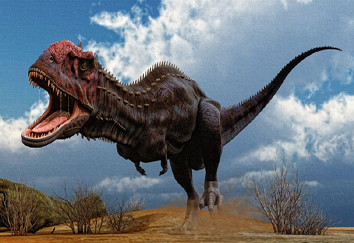
Majungasaurus Dinosaur meaning "Majunga lizard," is a fascinating dinosaur that lived during the Late Cretaceous period, approximately 70 to 66 million years ago. It belonged to the family Abelisauridae and is known for its unique features and intriguing behavior. Majungasaurus was a medium-sized theropod dinosaur, measuring about 6 meters (20 feet) in length and standing at a height of around 2 meters (6.5 feet) at the hip.
One of the most distinctive features of Majungasaurus was its skull. It had a deep and wide skull, with a prominent ridge and horn-like projections on top. Its jaws were equipped with sharp, serrated teeth, capable of delivering powerful bites. The shape of its skull suggests that it may have possessed a powerful bite force, making it an effective predator. Fossils of Majungasaurus have provided evidence of cannibalistic behavior among these dinosaurs. Bite marks and tooth gouges found on Majungasaurus bones indicate that they likely engaged in intraspecific combat and cannibalism.
Majungasaurus Facts :
| Name: | Majungasaurus Dinosaurs |
| Size: | 6 meters |
| Main Facts: | Majungasaurus, meaning "Majunga lizard," is a fascinating dinosaur that lived during the Late Cretaceous period, approximately 70 to 66 million years ago. |
In addition to preying on other dinosaurs, Majungasaurus likely fed on a variety of herbivorous dinosaurs that inhabited the same ecosystem. Its diet may have included sauropods, ornithopods, and possibly even small ceratopsians. Its sharp teeth and robust build would have allowed it to tear and consume flesh efficiently. Majungasaurus is primarily known from fossils found in Madagascar, where it inhabited a diverse and unique prehistoric environment.
The discovery of Majungasaurus has contributed significantly to our understanding of dinosaur evolution and behavior in the southern continents during the Late Cretaceous period. While there are still aspects of Majungasaurus's life and behavior that remain speculative, its distinctive features and cannibalistic tendencies make it a fascinating subject of study. The study of Majungasaurus and its relatives sheds light on the ecological dynamics and predator-prey relationships that existed in the ancient world, providing valuable insights into the diversity and behavior of dinosaurs during the Late Cretaceous.